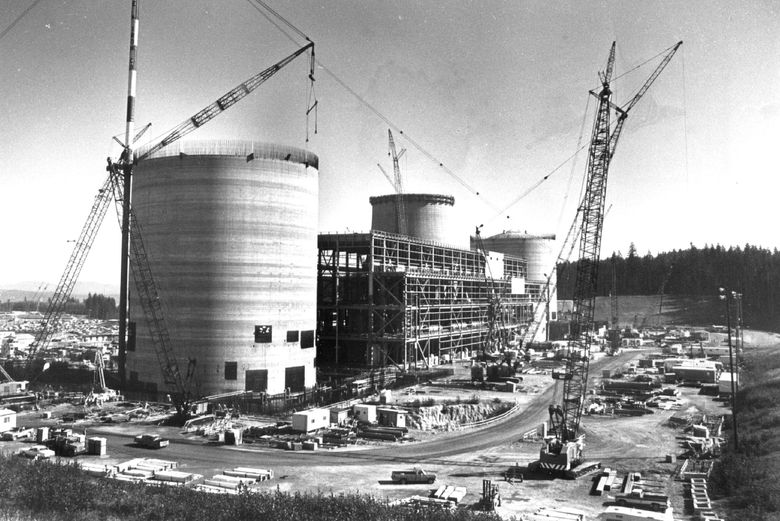
The Washington Public Power Supply System nuclear power plant is seen under construction at Satsop in 1981. WPPSS earned the derisive nickname pronounced “Whoops” and in 1982 defaulted on $2.2 billion in bonds issued to finance construction… (Associated Press)
By John Abbotts
Special to The Seattle Times
In the mid-1970s, I worked for a nonprofit organization in Washington, D.C., on energy issues. At a small dinner party hosted by a colleague, a staff member with the American Public Power Association made a comment about a utility consortium in Washington state. He said they were trying to construct five nuclear power plants at once and doubted they would succeed.
Ten years later I was living in Seattle, and opened a book review I wrote with, “I have seen the atomic future; it is spelled WPPSS and it doesn’t work.” By that time the Washington Public Power Supply System, which had earned the derisive nickname pronounced “Whoops,” in 1982 defaulted on $2.2 billion in bonds issued to finance construction of those reactors. They completed only one reactor, Plant 2 at the Hanford site.
The system began the projects based on overblown electricity consumption estimates. Acknowledged mismanagement by directors with no experience in nuclear engineering or with power plants of such a large scale resulted in repeated delays and cost overruns. The system also changed its name to Energy Northwest, in an effort to erase its image.
So when I read that X-energy, a Maryland-based company, agreed to supply up to 12 “small modular reactors” to Energy Northwest in Central Washington, my reaction was: Seriously? The first reactors would be around the nuclear plant on the Hanford site and are projected to come online by 2030. If all 12 reactors were built, total capacity would be 960 megawatts electric, less than the rated capacity of Energy Northwest’s only operating reactor, at 1,207 MWe. The July 2023 announcement “did not disclose what the project is expected to cost or how it will be financed.”
Another project provides a hint on finances. The U.S. Department of Energy has promoted SMRs from another company, NuScale, to be constructed at the department’s Idaho National Laboratory, with the power to be purchased by the Utah Associated Municipal Power System, a consortium of public power utilities across Utah and other western states, analogous to WPPSS/Energy Northwest. Original plans were for 12 reactors, each at 77 MWe. But in 2021, the project was reduced to six reactors, down to 462 MWe. Moreover, between 2021 and January 2023, estimated construction costs jumped from $5.3 billion to $9.3 billion, making the planned SMRs on a dollar-per-kilowatt basis, about as expensive as the Vogtle nuclear plants in Georgia, which could be the last large nuclear reactors in the U.S. In February 2022, the Institute for Energy Economics and Financial Analysis found that even at the earlier construction cost estimate, the NuScale reactors were already more expensive than renewable alternatives, and by 2029, when the first SMR was projected to come online, would be more than twice the cost of renewables. The Institute concluded the project was, “Too late, too expensive, too risky and too uncertain.”
In February 2019, Peter Bradford, former member of the U.S. Nuclear Regulatory Commission, warned that the chances of the NuScale “project being completed on budget and on schedule are slim indeed. Investments in nuclear construction projects have all too frequently resulted in large rate increases for utility customers, including customers of small municipal utilities and cooperatives.”
A quote attributed to Mark Twain, probably incorrectly, states “History may not repeat itself, but it does rhyme.” Will small reactors be the vehicle by which Energy Northwest “rhymes” with its earlier nuclear fiasco? Stay tuned.
John Abbotts served in Adm. Hyman Rickover’s nuclear submarine force, earned a biochemistry Ph.D. at the University of Washington and was a UW research scientist analyzing policy issues around Hanford cleanup. He lives in Seattle.
This article was published on September 11, 2023 at The Seattle Times.
